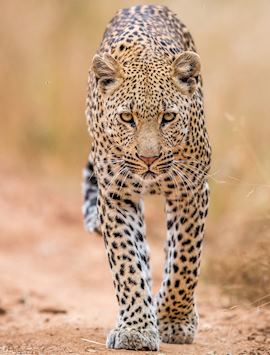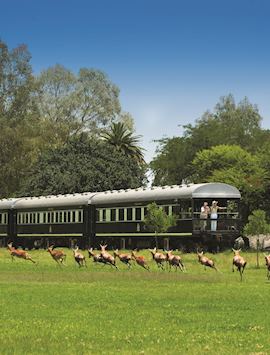By Audley South Africa specialist Chris
Whether you’re an avid safari-goer or it’s your very first time, South Africa’s diverse national parks and private reserves offer some of the best wildlife viewing opportunities in the whole of Africa. The majority are home to the Big Five, and sightings of lions, leopards, elephants, buffaloes, and rhinos in a single trip are not uncommon.
That said, each of South Africa’s safari locations have something different to offer, allowing you to build a trip shaped around what you’re most passionate about. You might want to experience a classic safari in the storied Greater Kruger Region, or perhaps you’d prefer to explore lesser-trodden trails in Madikwe Game Reserve. Whatever your style, I can help craft a South Africa safari holiday to suit you, including one or two of my favourite parks and reserves from below.
Kruger National Park

Best for a classic Big Five safari
The Greater Kruger Region is the oldest and largest area of undisturbed natural bush in South Africa. The park covers an immense area, allowing animals to follow ancient migration routes between South Africa, Zimbabwe and Mozambique.
Known as South Africa’s premier big cat viewing destinations, Kruger National Park and the wider Greater Kruger Region (which includes a variety of private reserves bordering the park) boast the highest densities and widest varieties of classic safari animals in the country. To the south and southwest, the rivers are bordered by woodland, which gives perfect cover to leopards. To the north the woodland gives way to open grassland, where on one trip, I saw six individual leopards in just three days.
If you’re looking to travel on a budget and are happy to drive yourself around the park, you can choose from an array of government-run lodges and camps within the park’s boundaries. For a more luxurious and exclusive experience, I highly recommend staying within the private wildlife reserves just outside.
Sabi Sands is arguably the most famous private reserve in the region, but there are also a number of smaller ones, such as the Timbavati, Thornybush, and Klaserie, where you'll see fewer vehicles and just as much wildlife. Both Sabi Sands and Timbavati have unfenced borders with Kruger National Park, so animals are free to move in and out. It isn’t unusual to see herds hundreds of buffaloes strong in this area.
Safaris in the Greater Kruger Region are predominantly vehicle-based, but it’s sometimes possible to take a bush walk too. The purpose of these walks is not to view the bigger animals but to introduce you to smaller creatures and insects, as well explaining the principles of tracking and spoor identification.
Where to stay in the Greater Kruger Region
With just a handful of thatched-roof chalets, a central relaxation space overlooking a seasonal waterhole, and an eco-conscious approach in all that it does, Bateleur Safari Camp is one of the region’s best stays. It’s perched above a dry riverbed within Timbavati Private Game Reserve, so you can often spot elephants, rhinos, and buffaloes as you unwind at the camp after an action-packed day.
The Eastern Cape’s parks & reserves

Best safari destination for families
The Eastern Cape is relatively new to safari compared to the Kruger region. That said, all wildlife viewing here provides ample opportunity to spot the Big Five: a stellar safari cast, including lions, leopards, rhinos, elephants, and cape buffaloes. During a three-night stay, your chances of seeing all five animals are good — though, as with all safaris, never guaranteed. The most elusive member of the Big Five in the Eastern Cape, the leopard, can be relatively hard to spot due to its secretive nature and the fact that they’re not as accustomed to vehicles in this region.
While on safari here, I was lucky enough to enjoy two incredibly rare sightings. First, a black rhino and her calf voluntarily walking straight past our vehicle, and then I spotted an extremely rare and nocturnal aardwolf during the day.
Most wildlife viewing is conducted on drives — however, you can also explore on foot. I’d recommend heading out with the more experienced guides, such as those in Lalibela Game Reserve. They’re able to bring the bush to life and highlight interesting details you may miss from a vehicle.
Unlike most other safari destinations, the Eastern Cape is malaria-free, making it ideal for families with children. It also boasts great weather from October to March, when it’s wetter in the Kruger region.
Where to stay in the Eastern Cape
Tucked away on a secluded hillside in Lalibela Private Game Reserve is Lentaba Safari Lodge. Each of its chalets has a private observation deck, so you can gaze across the valley bushveld as the sun sets. I love how the lodge has integrated traditional African decor throughout the chalets and communal spaces, creating a warm, relaxed atmosphere to retreat to after your twice-daily wildlife drives.
Lentaba welcomes children aged 12 and above, so if you have younger children, I recommend Riverdene Family Lodge in Shamwari Private Game Reserve instead. It’s a converted farmhouse with an unobtrusive safety fence around the grounds, meaning there’s plenty of space for children to run around and play safely, including a dedicated playground.
Madikwe Game Reserve

Best for a remote safari
Madikwe is the second largest wildlife reserve in South Africa and home to all the wildlife big hitters, but it often flies under the radar when people plan a safari. This makes it ideal if you want a more traditional safari experience with fewer vehicles around. I consider it one of the best safari destinations near Johannesburg, around a one-hour flight from the city by light aircraft or a five-hour drive. It’s also another malaria-free option for families.
The vast swathes of land that make up Madikwe Game Reserve are a beautiful combination of rocky outcrops and open plains. There are very few large trees, thanks in part to the 1,000 or so elephants found here, and also because of the arid climate, which is more similar to the Kalahari than the rest of South Africa.
Madikwe once had a reputation for its large population of wild dogs, but unfortunately due to the introduction of rabies by poachers, their numbers were decimated to only five individuals. However, recently the population has started to bounce back, and on my most recent trip I saw a litter of nine pups. I’ve also heard that, since my return home, another pack has successfully raised a litter.
Wild dogs are rarely at the top of a first-time visitor’s wish list, but once you’ve seen these charismatic and sociable animals frolicking in front of you, you’ll see why experienced safari-goers love them. Unlike other predators, they can be very active during the day, hunting up to three times with around a 75% success rate.
There are also over 400 species of bird in Madikwe, so it’s a popular choice for birdwatchers, with the opportunity for sightings of yellow-throated sandgrouses, kori bustards, and Temminck’s coursers, as well as barred wren-warblers.
Where to stay in Madikwe Game Reserve
Impodimo Lodge is my favourite place to stay in this area because of the vast number of elephants that come to drink at the watering hole during the mid-day siesta. There’s an underground hide that you can use to make the most of this view. Then, in the evening, you can unwind in your glass-fronted chalet, complete with an outdoor shower and a private deck surrounded by tamboti trees, so you can fully immerse yourself in nature. The lodge welcomes children of all ages and even has a dedicated programme to keep little ones occupied.
Phinda Private Game Reserve, KwaZulu-Natal

Best for combining wildlife with history
There’s so much to do in the KwaZulu-Natal area that you can spend two to three weeks just in this region, combining time on safari with an exploration of the military history and stark mountain landscapes that the region is known for. It’s my favourite part of South Africa.
Probably the best private wildlife reserve in this area is Phinda. Wildlife drives and walking safaris are both possible here, making the area perfect for more active safari-goers. It’s home to the Big Five, as well as &Beyond’s guide training school, and is particularly known for its rhino sightings. Cheetahs also thrive here due to smaller populations of lions and leopards that typically outcompete cheetahs elsewhere.
Phinda comprises several different biomes: woodlands, grasslands, wetlands, forests (including a rare dry sand forest), mountains, rivers, and marshes. This diversity gives you a chance to spot animals that you’re unlikely to see elsewhere in Africa, like the suni antelope, one of the smallest ungulates in the world.
It wouldn’t be accurate to say that KwaZulu-Natal is off the beaten track, but it’s certainly lesser known and quieter than other areas. As well as safari, you can also visit the battlefields of the Anglo-Boer and Anglo-Zulu wars, or if you want to walk, there are some excellent hiking trails through the Drakensberg Mountains.
Where to stay in Phinda Private Game Reserve
As is typical of KwaZulu-Natal, rolling scenery takes pride of place at &Beyond Phinda Mountain Lodge — you can admire the Lobombo foothills from across its hilltop grounds. The lodge’s collection of suites and cottages are spread out away from the main building, dotted down the hillside. I particularly like that each has a private plunge pool — somewhere special to unwind at the end of the day. As you take a dip, you can enjoy views of the bush and the foraging vervet monkeys that live within it.
Combine a safari with other highlights of South Africa

You could visit South Africa and never step foot in a safari park because there’s so much else to do, which is why I always like to add on time before or after a safari to explore the country’s rich culture, cuisine, and history.
Cape Town and The Winelands work well as a combination with most parts of South Africa. While there, you can hike Table Mountain, visit Robben Island, take guided food tours, and hop between vineyards on the Wine Tram. Then, you can fly directly from Cape Town to the Kruger Region or the Eastern Cape game reserves.
Johannesburg is the other major entry point to South Africa and has good connections to Kruger and Madikwe. During your stay you could visit the Apartheid Museum, the Pretoria Diamond Mines, or perhaps the Cradle of Humankind, where the largest number of hominid remains have been found.
Depending on what time of year you’re visiting South Africa, and particularly if you’re heading to Kruger, you may want to combine your safari with a visit to Victoria Falls, just a two-hour flight from Johannesburg.
Alternatively, if you’d like some true relaxation after your safari, you couldn’t wish for better than the azure waters and beautiful beaches of the Seychelles, Mozambique, or Mauritius. These all offer a huge range of hotels, from small self-catering apartments to the most opulent and indulgent beach stays. Or, within South Africa, there’s the Elephant Coast with its wild beaches and rustic oceanfront lodges.
Best time to go on safari in South Africa
Due to South Africa’s varied regional climates, the best time to visit for a safari depends on where you want to explore. In December and January, the Eastern Cape is hot and dry, meaning that thirsty animals congregate around waterholes in plain sight. Kruger is best in May, when temperatures cool and animals become more active, but you can enjoy dry weather until September. Likewise, dry conditions provide ample wildlife spotting opportunities in KwaZulu-Natal from May to September.
Read more about safari trips to South Africa
Start thinking about your experience. These itineraries are simply suggestions for how you could enjoy some of the same experiences as our specialists. They're just for inspiration, because your trip will be created around your particular tastes.
View All Tours in South Africa




